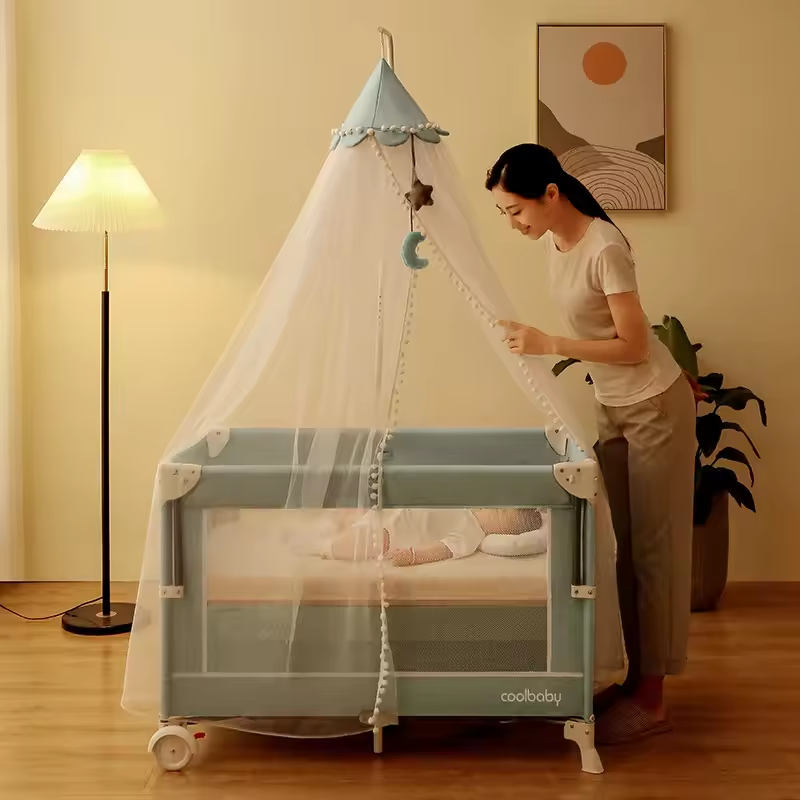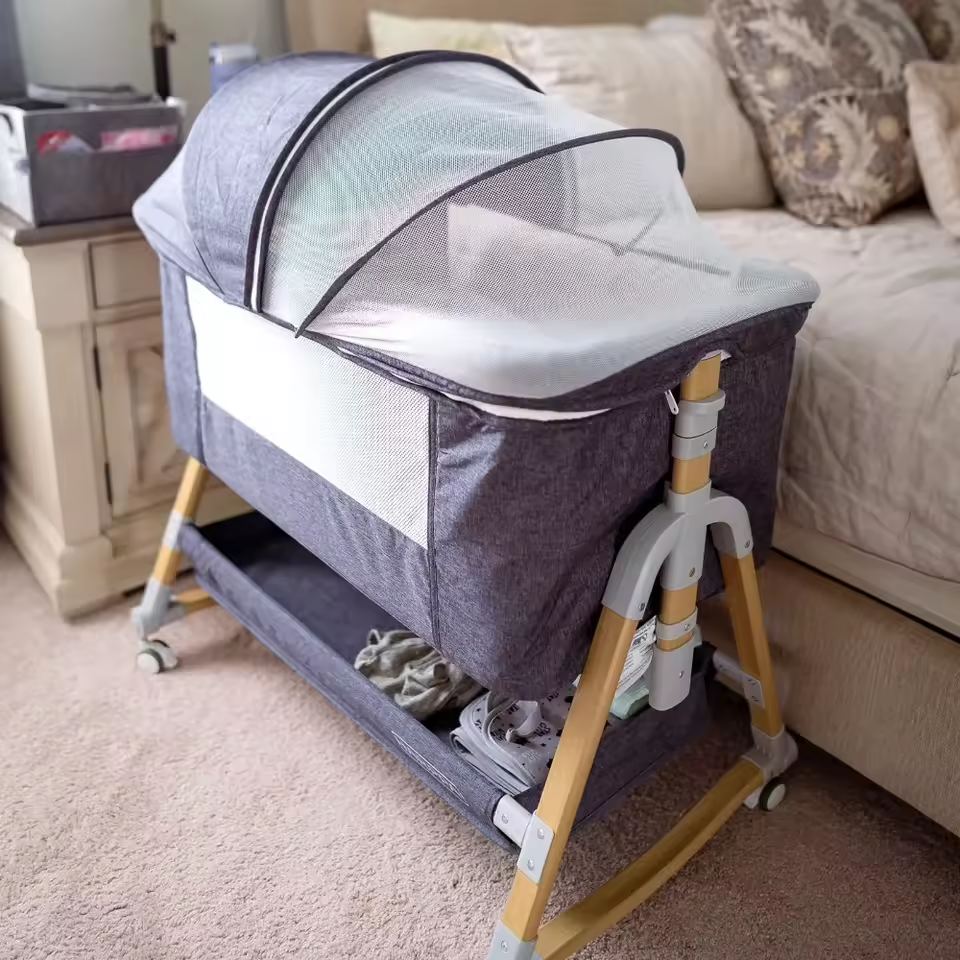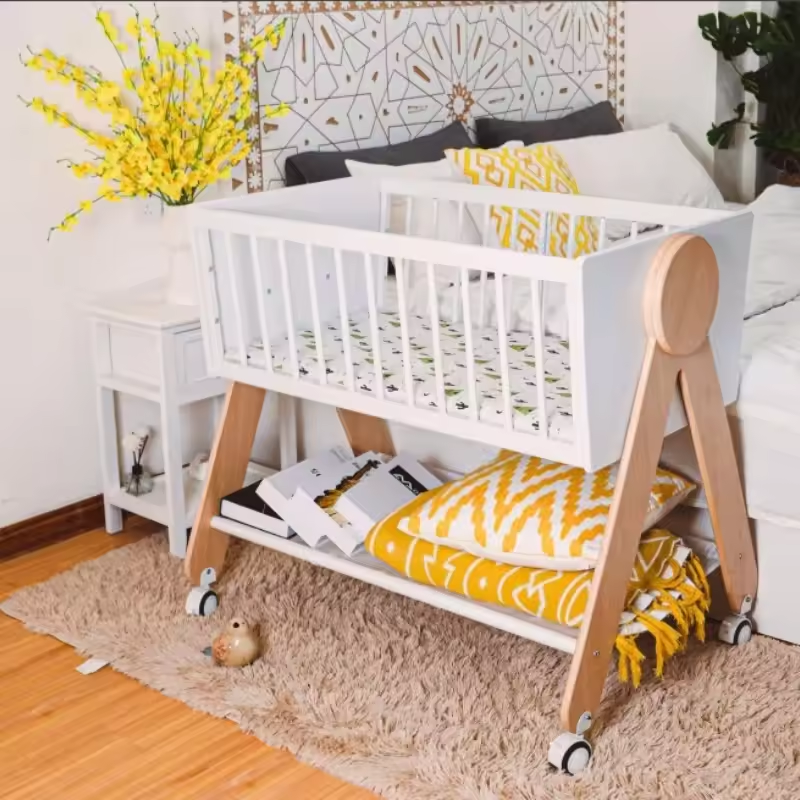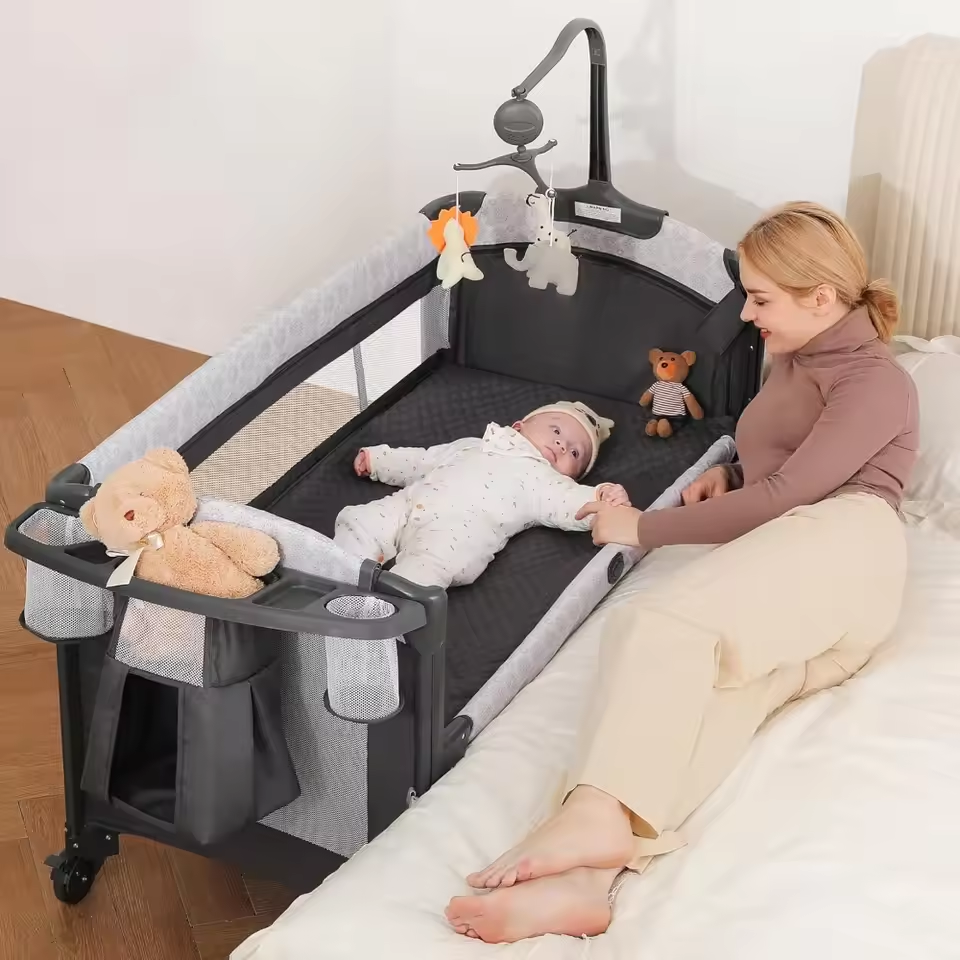Essential Safety Features for Baby Cot Bed
Ensuring the safety of your newborn is paramount when selecting a baby cot bed. Here are some crucial features to look for:

- Sturdy Construction: The cot bed must be robust and free from wobbles or loose parts that could harm your baby.
- Adjustable Mattress Height: This allows you to lower the mattress as your baby grows, reducing the risk of them climbing out.
- Slats Spacing: There should be no more than 6 cm between the slats to prevent your baby’s head from getting trapped.
- Teething Rails: These are protective covers that safeguard your baby’s teeth and the cot’s edges.
- Non-toxic Paint and Finishes: The baby cot bed should use safe, lead-free paint to prevent health hazards if your baby chews on the cot.
- Safety Standards Compliance: Look for certification that the cot bed meets the current safety standards.
- No Drop Sides: Although convenient, drop sides can be dangerous and are not recommended.
When it comes to the safety of baby cot bed, nothing should be overlooked. These features contribute to creating a secure sleeping environment for your little one.
Types of Baby Cot Bed: Pros and Cons
When selecting the right baby cot bed, parents are faced with several options, each with its advantages and disadvantages. Below is a breakdown of the common types of baby cot bed available in the market.
- Standard Cot Beds: These are the most common choice among parents. They usually come with fixed or convertible sides and often have adjustable mattress heights. Pros: widely available, variety of designs. Cons: can be bulky, not portable.
- Convertible Cot Beds: Designed to grow with your child, these cot beds can transform into toddler beds. Pros: long-term use, saves money over time. Cons: more expensive upfront, conversion kits may be needed.
- Travel Cots: Ideal for families on the go, travel cots are lightweight and foldable. Pros: highly portable, easy to store. Cons: less sturdy than standard cots, often have thinner mattresses.
- Bedside Cribs: These allow your baby to sleep close to you without sharing the same bed. Pros: promotes bonding, easier nighttime feeding. Cons: short-term use, not as versatile.
- Bassinettes: Smaller and more compact than traditional cot beds, perfect for newborns. Pros: fits in smaller spaces, easy to move around. Cons: only suitable for short-term use.
Each type of baby cot bed serves different needs and lifestyles. Consider the pros and cons carefully, alongside safety features, to ensure the perfect choice for your newborn.
The Importance of Proper Mattress Selection
Choosing the right mattress for your baby’s cot bed is as vital as the cot bed itself. A good mattress not only provides comfort but also supports your baby’s growing bones. Here’s what you should keep in mind:
- Firmness: A firm mattress reduces the risk of suffocation and is safer for your infant’s development.
- Fit: The mattress must fit snugly within the cot with no gaps that could trap your baby’s limbs.
- Breathability: Opt for a breathable mattress to ensure proper air circulation and prevent overheating.
- Hypoallergenic Materials: Consider mattresses made from materials that prevent allergens from accumulating.
- Waterproof Cover: Spills and accidents happen; a waterproof cover will protect the mattress and make cleaning easier.
- Quality: Invest in a high-quality mattress that holds its shape and provides consistent support over time.
Proper mattress selection is a step towards guaranteeing your baby safer and more peaceful sleep. Remember, your baby will spend a considerable amount of time in their cot bed, so pick a mattress that caters to safety and comfort.
Standards and Certifications for Baby Cot Bed
When picking out a baby cot bed, observing standards and certifications is key. These measures ensure that the cot bed has undergone stringent testing for safety. Be sure to look for the following:
- Consumer Safety Standards: In many countries, baby products must meet strict safety criteria. Look for approval from recognized standards such as ASTM International or the British Standards Institution (BSI).
- Certification Marks: Labels like the Juvenile Products Manufacturers Association (JPMA) certification indicate a product’s compliance with safety standards.
- Local Regulations: Some regions have specific requirements for baby cot bed. Always confirm that the product complies with local laws.
- Non-toxic Certification: Certifications for non-toxic materials, such as the Oeko-Tex Standard 100, assure that the cot bed is free from harmful substances.
Reading and understanding safety certifications can help make an informed decision for your baby’s safety. These certifications and standards are not just suggestions. They are a product’s proof of meeting the highest safety protocols. Always check for these before you make your purchase.
Factors to Consider When Choosing a Baby Cot Bed
When you’re in the market for a baby cot bed, there are several key factors you should take into account to ensure your little one’s safety and comfort, as well as your convenience.
- Space and Size: Consider the size of the room where you’ll place the cot bed. Make sure it allows for easy movement around the room and the cot bed fits well.
- Lifestyle Compatibility: Think about how the cot bed fits with your family’s lifestyle. If you travel often, a portable travel cot may be ideal.
- Budget: While safety should never be compromised, it’s important to find a cot bed that fits within your financial means.
- Design: Look for a design that not only meets safety standards but also blends seamlessly with your nursery’s theme.
- Future Use: If you’re planning for more than one child, consider if the cot bed can be reused or if it converts into a toddler bed.
- Ease of Cleaning: Babies are messy. Choose a cot bed that’s easy to clean, with removable and washable parts.
- Mattress Compatibility: Make sure that you choose a mattress that fits perfectly with the cot bed to prevent any safety hazards.
- Durability: A well-built cot bed can last through multiple children, so pay attention to its construction quality.
- Assembly: Check if the cot bed is easy to assemble or if you’ll need professional help, as complex assembly can be a hassle.
- Accessories: Some cot beds come with additional features like drawers for storage. Decide if these are necessary for your needs.
Choosing the right baby cot bed requires careful thought and consideration. By taking these factors into account, you can select a cot bed that ensures safety, provides comfort, and offers convenience, all while staying within your budget. Keep these points in mind to create a nurturing and secure sleep environment for your newborn.
Tips for Assembling and Maintaining Baby Cot Bed
Assembling and maintaining your baby cot bed are critical steps to ensure long-term safety and usability. Here’s how to do it right:
- Follow Instructions: Always read the manufacturer’s guide before starting. It holds key assembly details.
- Check Parts: Prior to assembly, confirm that all parts are present and in good condition.
- Use Proper Tools: Employ the correct tools as indicated by the instruction manual to avoid damaging parts.
- Secure Fittings: Make sure all screws and bolts are tight to prevent any wobbles or collapses.
- Regular Inspections: Periodically check the cot bed for loose components or wear and tear.
- Cleaning: Wipe down the cot bed with a damp cloth and mild detergent. Avoid harsh chemicals.
- Mattress Care: Keep the mattress clean, dry, and well-fitted for safety and comfort.
- Avoid Moisture: Protect the cot bed from dampness which can cause mold and weaken the structure.
- Direct Contact: Steer clear of placing the cot bed near radiators or windows to reduce risk of damage.
- Instruction Storage: Keep the assembly guide in case you need to reassemble the cot bed later.
By closely adhering to these tips, you will maintain a sturdy and secure environment for your baby cot bed. Regular upkeep contributes significantly to the longevity and safety of the baby cot bed.
Baby Cot Bed Design: Combining Safety with Aesthetics
Choosing a baby cot bed includes balancing style with safety. Both elements are key for a pleasant nursery. Here’s what to consider:
- Style and Safety Hand in Hand: The cot bed should be safe but also fit your decor.
- Color Choices: Pick non-toxic paints that match room colors and are safe for babies.
- Aesthetic Features: Select design features that are functional and add to the room’s charm.
- Harmonious Design: Look for designs that blend with other furniture in the nursery.
- Customization: Some cot beds offer custom options like engraving or color varieties.
- Non-Hazardous Decorations: If including toys or mobiles, ensure they are securely attached and pose no choking risk.
Remember, the design should never compromise the baby cot bed’s safety. Harmony between aesthetics and safety creates the perfect sleeping space for your newborn.
Transitioning from a Cot Bed to a Toddler Bed: When and How
Transitioning your child from a baby cot bed to a toddler bed is a significant milestone. It symbolizes that your little one is growing up and needs more space to sleep and play. But when is the right time to make this switch, and how can you ensure a smooth transition?
When to Transition: Age and Development Clues
Children typically move to a toddler bed between 18 months and 3.5 years old. However, age might not be as crucial as your child’s development. Look for clues like:
- Your child is climbing out of the cot.
- They have outgrown the length of the cot bed.
- They show interest in big kid beds.
How to Prepare Your Child: Strategies for Transition
The idea of changing beds can be daunting for a toddler. To make it easier:
- Talk about the transition as an exciting step towards being ‘big’.
- Let them pick out their new bed or bedding to build excitement.
- Start by using the toddler bed for naps.
Ensuring Safety: Adjustments to the New Bed
Safety remains the top priority during this transition:
- Ensure the toddler bed has guard rails to prevent falls.
- Confirm it’s low to the ground to make access easy.
- Verify mattress firmness and fit to maintain comfort and safety.

Creating Comfort: Same Bedtime Routine
Keep your child’s bedtime routine consistent. It helps them feel secure despite the change:
- Read the same bedtime stories.
- Tuck them in with their favorite toy.
- Maintain usual sleeping times.
Dealing with Challenges: Patience and Support
It’s normal for kids to test boundaries or resist changes:
- Stay patient if they try to get out of bed.
- Reassure them if they feel uneasy.
By considering these points, transitioning from a baby cot bed to a toddler bed can be a positive experience. It’s about timing, preparation, safety, comfort, and patience. With the right approach, your toddler will soon love their new bed.